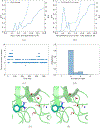Efficient Sampling of Cavity Hydration in Proteins with Nonequilibrium Grand Canonical Monte Carlo and Polarizable Force Fields
- PMID: 38417108
- PMCID: PMC11663258
- DOI: 10.1021/acs.jctc.4c00013
Efficient Sampling of Cavity Hydration in Proteins with Nonequilibrium Grand Canonical Monte Carlo and Polarizable Force Fields
Abstract
Prediction of the hydration levels of protein cavities and active sites is important to both mechanistic analysis and ligand design. Due to the unique microscopic environment of these buried water molecules, a polarizable model is expected to be crucial for an accurate treatment of protein internal hydration in simulations. Here we adapt a nonequilibrium candidate Monte Carlo approach for conducting grand canonical Monte Carlo simulations with the Drude polarizable force field. The GPU implementation enables the efficient sampling of internal cavity hydration levels in biomolecular systems. We also develop an enhanced sampling approach referred to as B-walking, which satisfies detailed balance and readily combines with grand canonical integration to efficiently calculate quantitative binding free energies of water to protein cavities. Applications of these developments are illustrated in a solvent box and the polar ligand binding site in trypsin. Our simulation results show that including electronic polarization leads to a modest but clear improvement in the description of water position and occupancy compared to the crystal structure. The B-walking approach enhances the range of water sampling in different chemical potential windows and thus improves the accuracy of water binding free energy calculations.
Figures






Similar articles
-
Enhancing water sampling of buried binding sites using nonequilibrium candidate Monte Carlo.J Comput Aided Mol Des. 2021 Feb;35(2):167-177. doi: 10.1007/s10822-020-00344-8. Epub 2020 Sep 24. J Comput Aided Mol Des. 2021. PMID: 32968887 Free PMC article.
-
Enhancing sampling of water rehydration upon ligand binding using variants of grand canonical Monte Carlo.J Comput Aided Mol Des. 2022 Oct;36(10):767-779. doi: 10.1007/s10822-022-00479-w. Epub 2022 Oct 6. J Comput Aided Mol Des. 2022. PMID: 36198874 Free PMC article.
-
Assessing the Predictive Power of Relative Binding Free Energy Calculations for Test Cases Involving Displacement of Binding Site Water Molecules.J Chem Inf Model. 2019 Feb 25;59(2):754-765. doi: 10.1021/acs.jcim.8b00826. Epub 2019 Jan 29. J Chem Inf Model. 2019. PMID: 30640456
-
CHARMM additive and polarizable force fields for biophysics and computer-aided drug design.Biochim Biophys Acta. 2015 May;1850(5):861-871. doi: 10.1016/j.bbagen.2014.08.004. Epub 2014 Aug 19. Biochim Biophys Acta. 2015. PMID: 25149274 Free PMC article. Review.
-
Practical Applications of Grand-canonical Electronic Structure Calculations in Electrochemical Simulation.J Phys Chem Lett. 2025 Feb 13;16(6):1470-1477. doi: 10.1021/acs.jpclett.4c03323. Epub 2025 Feb 2. J Phys Chem Lett. 2025. PMID: 39895225 Review.
Cited by
-
Electronic Polarization Leads to a Drier Dewetted State for Hydrophobic Gating in the Big Potassium Channel.J Phys Chem Lett. 2024 Jul 25;15(29):7436-7441. doi: 10.1021/acs.jpclett.4c01359. Epub 2024 Jul 15. J Phys Chem Lett. 2024. PMID: 39008088 Free PMC article.
References
-
- Brooks III CL; Karplus M; Pettitt BM Proteins: A Theoretical Perspective of Dynamics, Structure & Thermodynamics. Adv. Chem. Phys. 1988, LXXI.
-
- Helms V Protein dynamics tightly connected to the dynamics of surrounding and internal water molecules. ChemPhysChem 2007, 8, 23–33. - PubMed
-
- Fersht A Structure and Mechanism in Protein Science: A Guide to Enzyme Catalysis and Protein Folding; W.H. Freeman and Company, 1999.
-
- Silverman DN; McKenna R Solvent-mediated proton transfer in catalysis by carbonic anhydrase. Acc. Chem. Res. 2007, 40, 669–675. - PubMed
MeSH terms
Substances
Grants and funding
LinkOut - more resources
Full Text Sources
